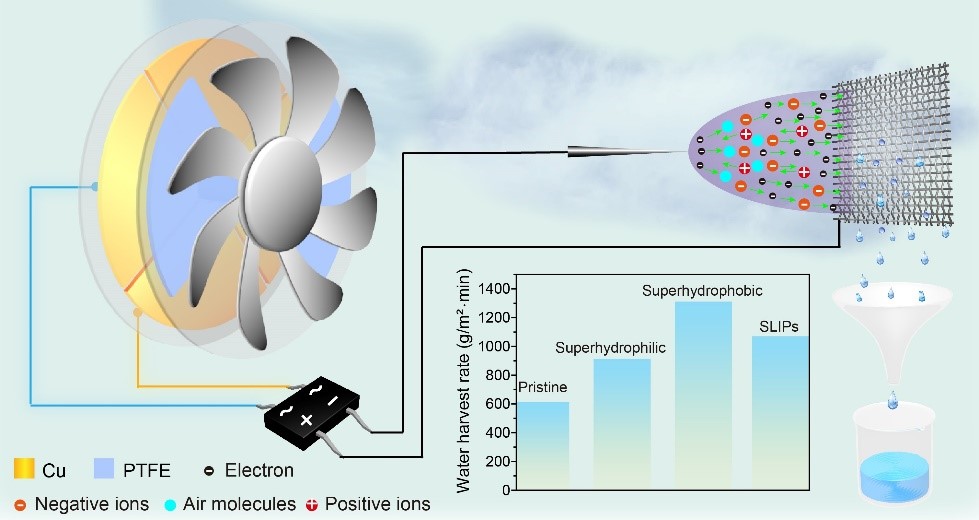Recently, the research result of Prof. Gang Cheng's group "A water collection system with ultra-high harvest rate and ultra-low energy consumption by integrating triboelectric plasma" was published in the famous international journal of Nano Energy (IF=17.881, JCR District 1).
Article link: https://doi.org/10.1016/j.nanoen.2021.106518
According to the World Water Association, there are about 2.2 billion people lacking access to safety drinking water worldwide. In many remote arid and semi-arid areas, where it rains very little all year round, people collect fresh water through seawater desalination, waste water recycling after treatment, groundwater extraction, etc. However, the general bulky size and high energy-cost limit the aforementioned techniques’ real application in rural areas. Considering that lots of dry areas such as islands, coastal deserts and mountains experience dense fog frequently and fog is actually made up of tiny droplets with diameter 1-10 μm, it is therefore very promising to relieve the water scarce situation by collecting fog efficiently through rational design.
To this context, researchers have designed a variety of artificial fog collection systems inspired by the relationship between microscale structures and efficient fog collection function occurred in natural world. Due to the comprehensive advantages of low cost, excellent aging resistance, zero power consumption, and easy preparation, mesh typed (especially metal meshes) fog collectors have been widely applied to collect fog in large scale. Traditional mesh fog collectors capture fog droplets mainly through inertial collision. Along the wind stream, fog droplets advance and collide with mesh frames, namely deposition. When droplet accumulation gets to a critical size, it slides down off the mesh surface under gravity and is collected by storage vessel. To be noted, the mesh openings do not collect fog droplets, but decrease the pressure drop before and after the mesh, further help to maintain the fog flux towards the fog collector. Despite of decades of endeavor, the biggest challenge in fog collection remains to be low deposition efficiency as well as low shedding off rate of water droplets, which hinder continuity and also lead to poor fog/water conversion efficiency, about 1%-2%, of the final fog collection cycle.

A water collection system with ultra-high harvest rate and ultra-low energy consumption by integrating triboelectric plasma
Here, a self-powered fog harvesting system by integrating triboelectric plasma is developed. Taking the advantage of space charges injected through triboelectric plasma into the fog flow, tiny water droplets deposit onto the collecting mesh with unprecedentedly high efficiency. By endowing the mesh with superhydrophobicity, water collected on it sheds off quickly, which guarantees fast regeneration of the fog collection system. The final water harvest rate reaches 1311.79 g/(m2·min), about 3.28 times of the maximum value reported in literatures, with the fog/water conversion efficiency of 55.5%. More importantly, the energy consumption is minimized to 0.052 kWh/m3, far lower than ~3 to 5 kWh/m3 energy consumption in the frequently-used reverse-osmosis desalination technique and ~ 2 kWh/m3 in the newly-developed high voltage power supply-assisted fog harvesting system. A physical model based on the synergistic effect of triboelectric plasma and surface wettability is proposed to illuminate the mechanism. This self-powered efficient fog harvesting system provides great promise to relieve local water scarcity energy-effectively.
Dr. Guangqin Gu is the first authors of the paper, and Prof. Jie Ju, Prof. Gang Cheng, and Prof. Zuliang Du are the co-corresponding authors of this paper. This work was supported by funding from the National Natural Science Foundation of China, the Science and Technology Department of Henan Province, China Postdoctoral Science Foundation, and Henan University.